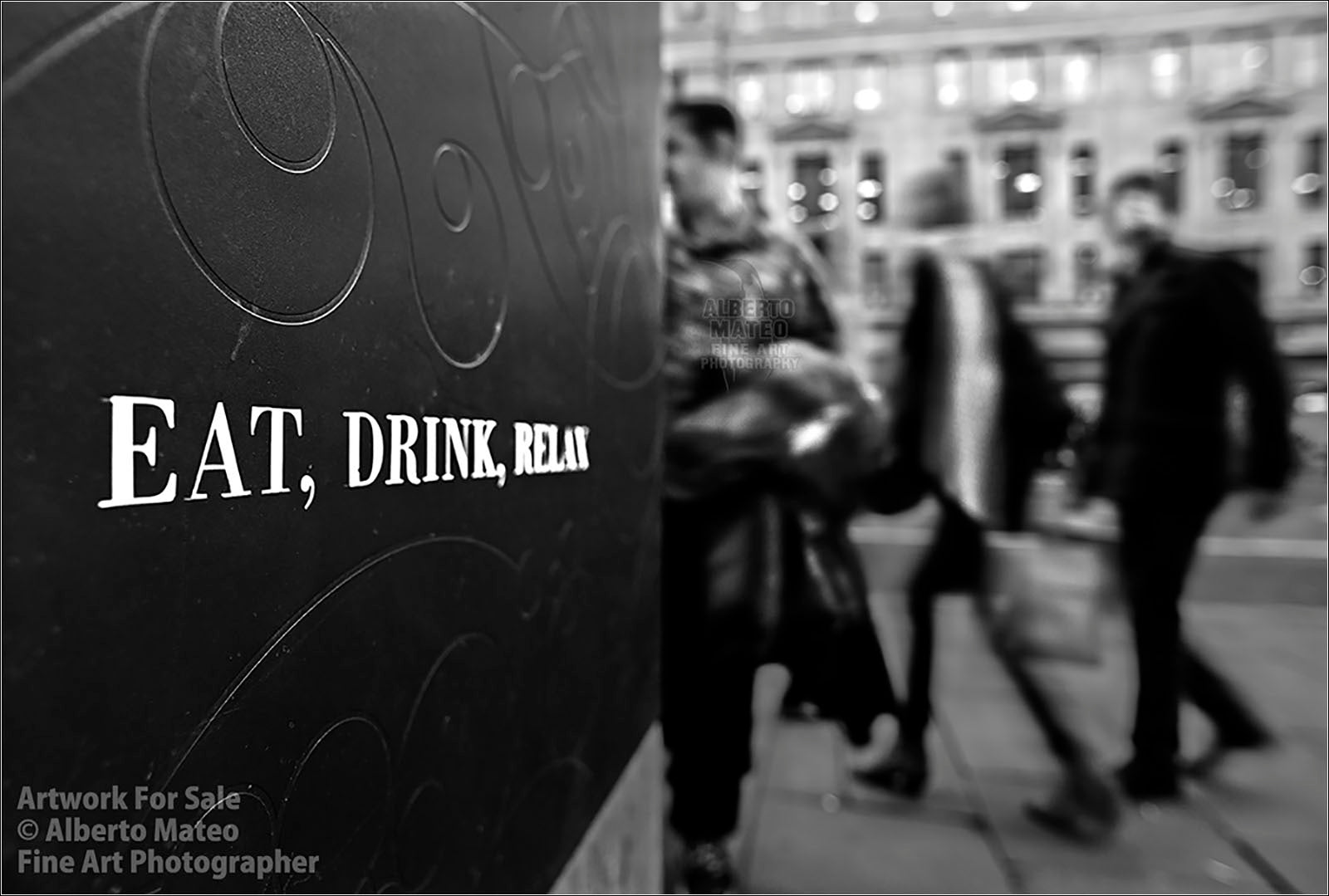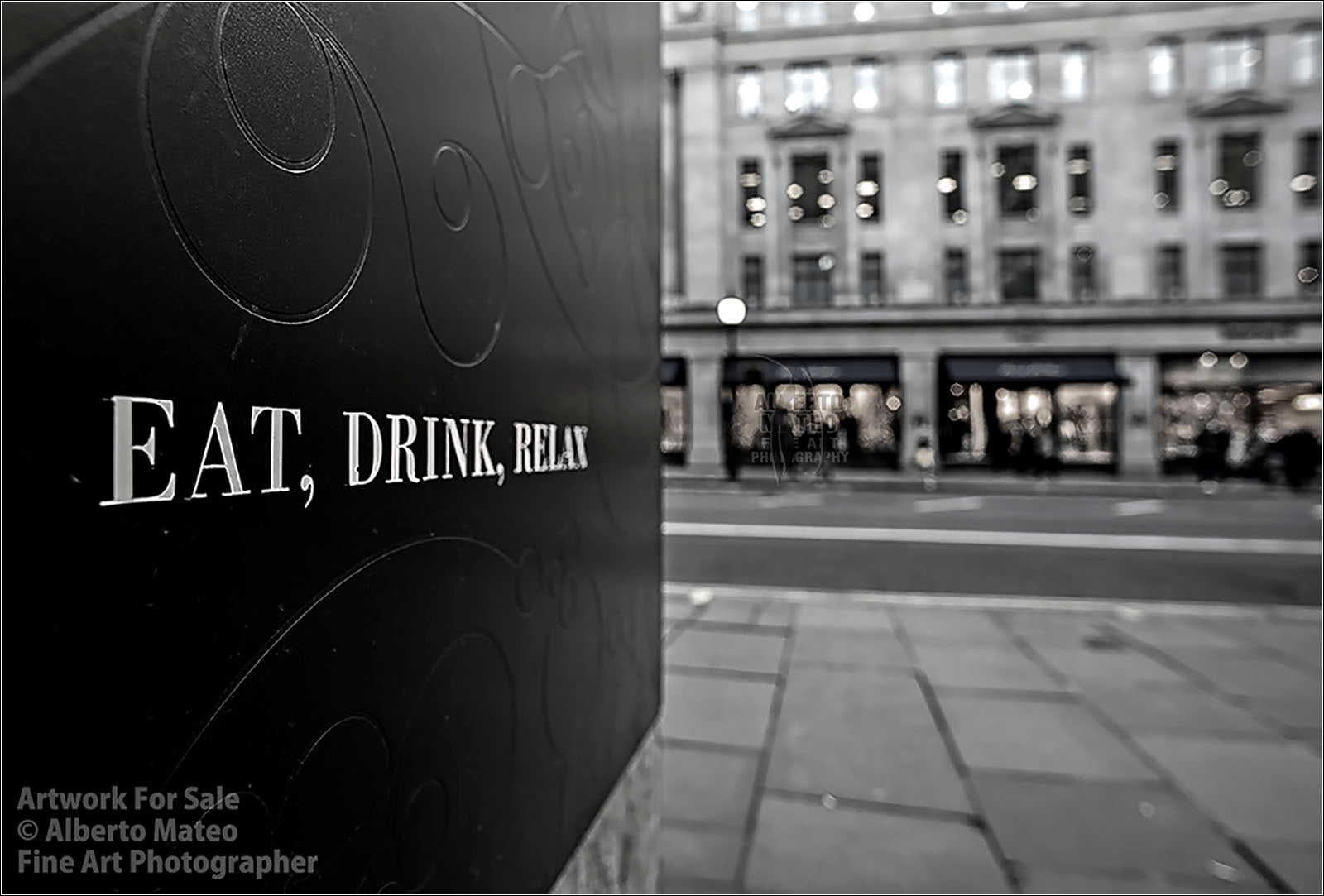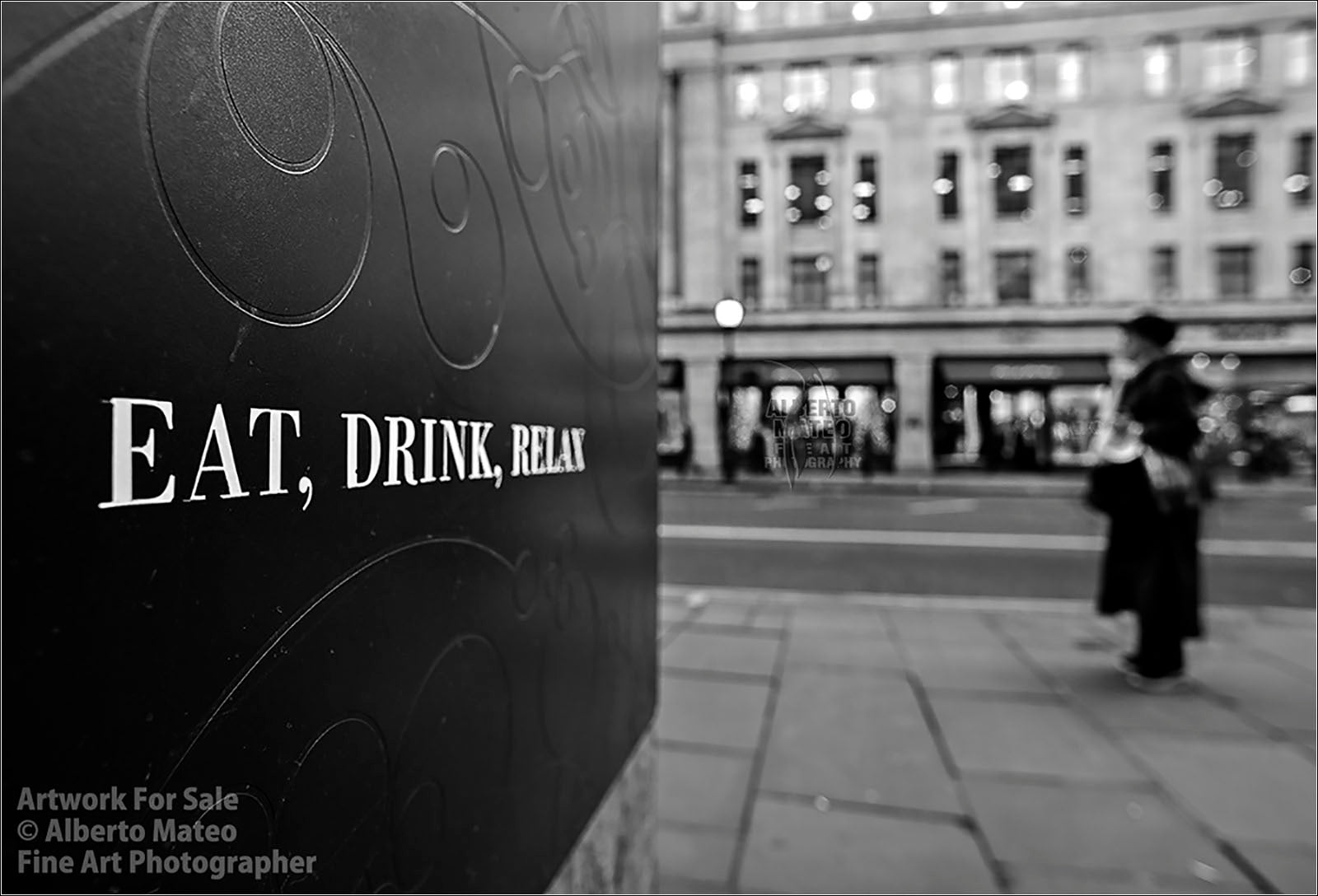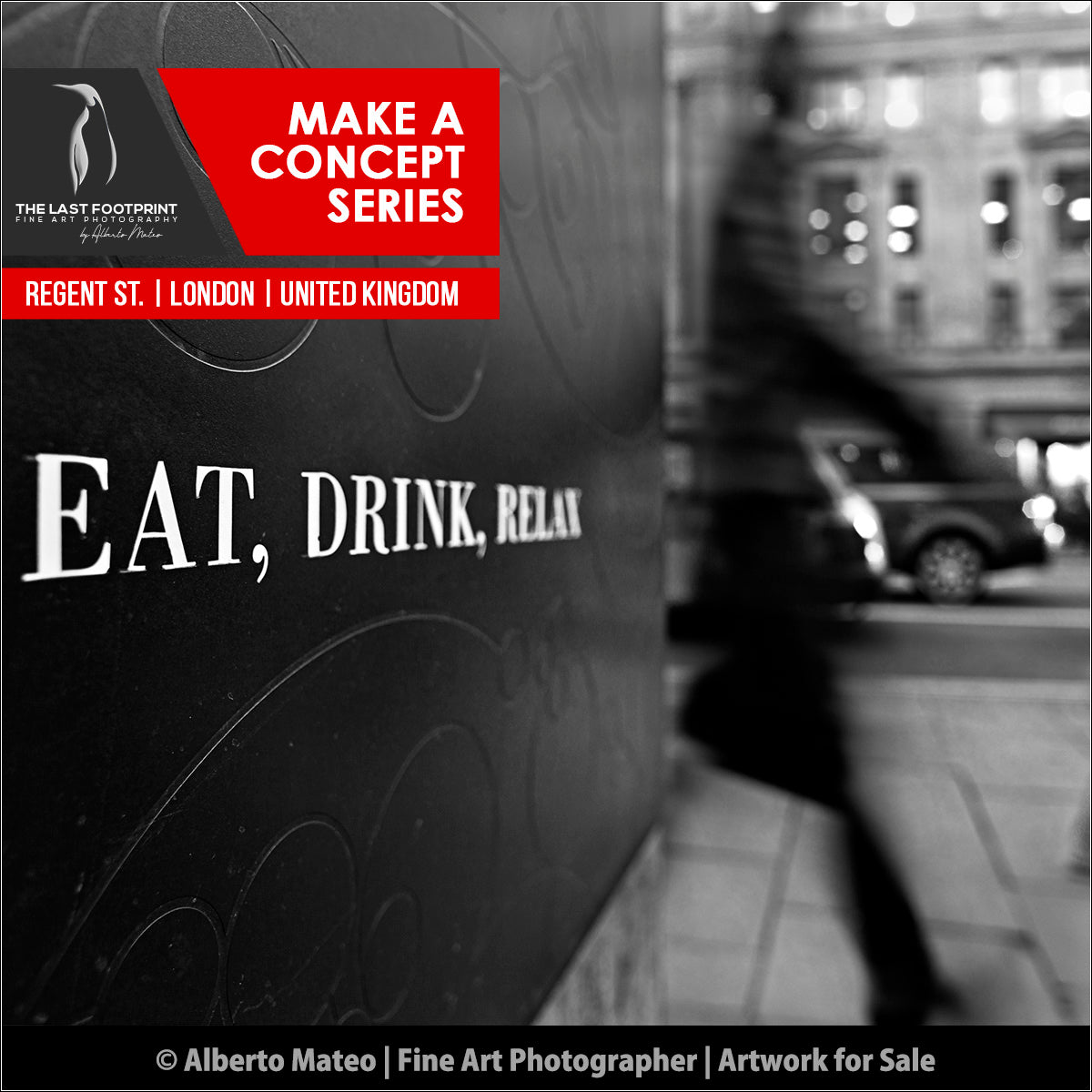



“The Happy Ones???” – Photographic Series of Four Fine Art Prints by Alberto Mateo
PART I - THE PHOTOGRAPHIC SEQUENCE [665 words – 3.2 min]
“To be content with little is difficult;
to be content with much, impossible.”
(Marie von Ebner-Eschenbach)
Why sometimes a Series of pictures is better than a single one? Because it is a wonderful tool to communicate an idea or concept, sometimes even more expressive than a single image. Combining photographs any photographer is able to play with juxtaposition and comparison of elements in the frame, with moving and still subjects. When he puts together two or more similar pictures, the human brain itself establishes a comparison among them, a comparison that, wisely used, allow any photographer to assert or reinforce a visual affirmation. As Minor White stated: “A sequence of several images can be thought as a single statement”.
When I was working on a reportage in the Regent Street in London I saw this sentence: “Eat, Drink, Relax.” that had been strategically written at the entrance of a small alley dedicated to the leisure of the visitors and workers who spent the day in this commercial and centric street in London. I thought that it was a good opportunity to relate a mass of commuters in a centric street of a big city like London with the goals they chase everyday.
If there is a misused capacity of the medium of photography nowadays is its ability to make us think, to raise ideas about our everyday life, our behavior and the consequences of our acts.
The message written in the wall: “Eat, Drink, Relax.” in a place where thousands of people (who do not even care about it) pass next to everyday, made me think if that was a conclusive goal in life and how far we could to get it. In addition, it made me think how unmindful we commute and behave in our everyday environment, and thought that this series could make think others about it.
If there is a misused capacity of the medium of photography nowadays is its ability to make us think, to raise ideas about our everyday life, our behavior and the consequences of our acts.
Before explaining how I planned and executed this Series, I would like to talk about three concepts in photography that go hand in hand regarding the number of pictures used to transmit an idea in photographs: the Decisive Moment, the Reportage and the Sequence.
a) The Single Photograph
Sometimes a single picture is able to resume and express an idea so effectively in a compositional, visual and symbolic sense that can stand alone on its own as a representation of it. This type of ideal image was called (and chased) by Cartier-Bresson, “Decisive Moments”. He looked for these special moments during all his life, but even a great master of photography as he was, was not able to capture many of those special images throughout his whole life. The reality is that decisive moments do not happen every-day in front of the lens of a photographer (even if he was able technically to achieve them, and was in the mental state to look for them).
b) The Reportage
A reportage is the best next thing we photographers can take. Capture a group of pictures, as varied as possible, around a common subject that can be published together in company of a text to explain a concept. Most magazines (like National Geographic) have been divided during decades in reportages. The fact is that the union or Text and Photographs is the most effective way to explain something. That is why it has been the most common schema in paper journalism during decades.
c) The Photographic Sequence
Another possibility is taking a small set of pictures that, put together, explains an idea. Sequences allow us to make comparisons.
There are two types of sequences:
-
Action Sequences, where the view point is always the same. The camera is always at the same position and subjects move inside the frame.
- In Narrative Sequences the camera can move around the subject. This can be a bit more like a traditional reportage.
A sequence is not always the best solution (very often it is not even achievable), but it’s a possibility we photographers do not usually think about when we are approaching a subject.
In a sequence we try to transmit a meaning using differences in the pictures: maybe the position of the subject, or maybe there are different subjects in each image…
PART II - TIPS TO MAKE AN EFFECTIVE PHOTOGRAPHIC SEQUENCE [965 words – 4 min]
There are some aspects you have to take into account when working with sequences. In the final presentation of a Series it is recommendable that all images ‘work together’ and are presented at the same size, with the same style (black and white or color). There has to be a ‘continuity’ and they have to be perceived as one image. Here are some ideas to make the series work be perceived as a unified work.
a) Make sure that your camera does not move between the frames.
This Series: “The Happy Ones?” is an example of Action Sequence. There were two foes to fight against when I was shooting these images:
b) Vibrations that blur the images
I had to use a big tripod head to ensure that the lens was not going to get vibrations from the movement of the mirror of my Nikon D800.
I set the camera on a Manfrotto 055 Pro tripod legs with a Gitzo 1372M Head. This is a heavy combination for street photography, not the best for your shoulder and back, but one that has many advantages when you do not want your tripod to move at all or when you are shooting with a heavy and bulky lens like the Nikon 80-200 2.8 AF that weights 1300g and the smallest vibration of the lens may blur the images you are taking.
New mirrorless telemeter cameras don’t need a mirror to show the image, so they don’t have the problem of the vibrations that the mirror produces. One step ahead in these new camera bodies.
Every action can be dissected in smaller ones that altogether define the complete activity, but some of them have more meaning, are more evocative related to the general significance of the complete action. Choose those special moments and your sequence will improve.
c) Movement of the Camera
When photographs are taken with a wide angle, the minor movement of the position of the lens produces big changes in final composition. If you are using a long lenses the movement of the camera position is not so critic, it does not produce so big changes of point of view.
In this case I was using a Nikon 20mm 2.8 AF and the big weight of my tripod-head combination made difficult for the combination to move.
d) Choose the Defining Moments of the action you are registering.
Every action can be dissected in smaller ones that altogether define the complete activity, but some of them have more meaning, are more evocative related to the general significance of the complete action. Choose those special moments and your sequence will improve.
There are THREE MOMENTS captured in FOUR PICTURES in my series, “The Happy Ones?”
a) Two pictures register the most common situation in this street located in the center of London when it is full of commuters that walk with the auto pilot switched on before arriving to, or after going out from, their daily place of work, walking thinking in their own problems, maybe bored, without paying much attention to the events around them. These images stand for the SOCIETY AS A WHOLE, as a shapeless set of individuals who live and behave the same way to get their social and personal goals.
I decided to repeat this picture in the series because they stated the most common situation. They set a ‘visual zero’ I could relate conceptually the other images to. The other two images transmit the conceptual meaning by contrast with these two ones.
b) A solitary woman that has stopped in front of the lens. She was thinking, maybe she had forgotten to buy something. She may stand for each individual who thinks, who is aware of herself in the big group. This image represents the INDIVIDUAL who is part of the society, who thinks on her own.
c) The empty street, in a moment where no pedestrians where passing by. It stands for the CITY itself, in this case London, but the photograph could have been taken in any big city in the world, an empty scenario where this situation takes place every-day.
e) Composition: Set your camera in the exact position
When using wide angles the position of the camera is critic.
The most difficult part of taking this pictures was setting the camera in the right position. The text was written at the height of my hip, which forced me to work with one knee on the ground. To set the tripod at the needed height I had to use it without any of the sections extended, at its minimum height.
I composed the image so that the text got perfectly centered at the left, at mid height, with the focus at the nearest letters in the camera, leaving all the right part of the frame for the moving pedestrians.
The vertical part of the wall has to be EXACTLY AT THE CENTER OF THE FRAME for the composition to be effective. In addition, to avoid any possibility of convergence of lines, the lens had to be absolutely perpendicular (no excuses here) to the wall I had on my left.
The juxtaposition of the left part of the frame completely static, without any movement registered and the right one, with different position of pedestrians is one of the key facts that makes this group of photographs work.
5. Always be open to any idea that may arise when you are shooting, even if it is not directly related with the subject you are photographing.
This group of photographs was not related with the work I had in hand at the moment, but when I saw the text written in the wall, the idea of relating the text with the flood of citizens that walked next to it without taking notice of the text, I think it was worth the extra effort to execute it.
You can see the four images of the series at my site:
The Happy Ones?, Photography Series 1/4 | Regent Street London, UK.
The Happy Ones?, Photography Series 2/4 | Regent Street London, UK.
The Happy Ones?, Photography Series 3/4 | Regent Street London, UK.
The Happy Ones?, Photography Series 4/4 | Regent Street London, UK.
EXIF DATA:
Camera Model: Nikon D800
Lens: Nikon 20mm 2.8 AF
SETTINGS: Aperture: f5 | Shutter Speed: 1/30 second | ISO: 250
LIST OF USED GEAR
Tripod: Manfrotto 055 Pro with Gitzo 1372M Head
Memory Card: Sandisk SD Extreme 64Gb
I would like to read about your ideas and opinions. Have you taken any similar series? If so, have you planned it the same way? Please comment my images and tell me about your experience while taking Photographic Series.






0 comments